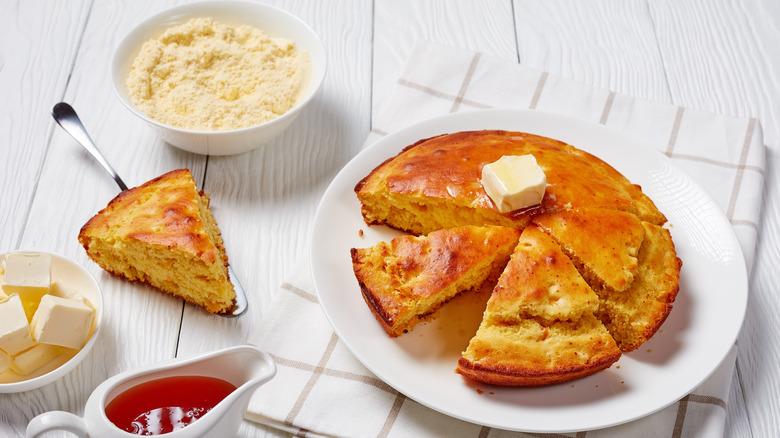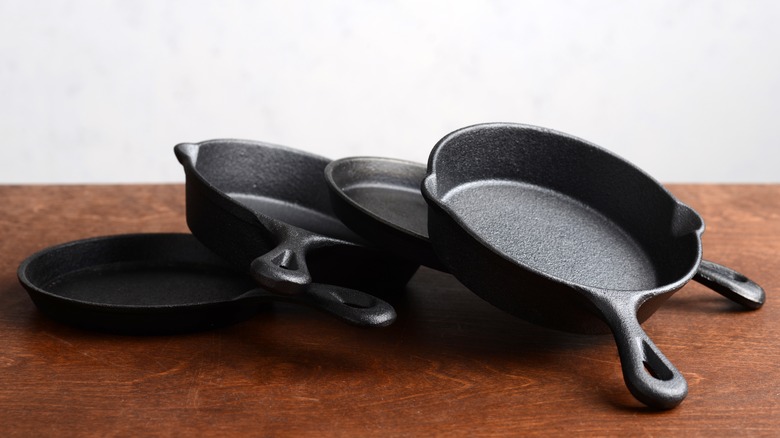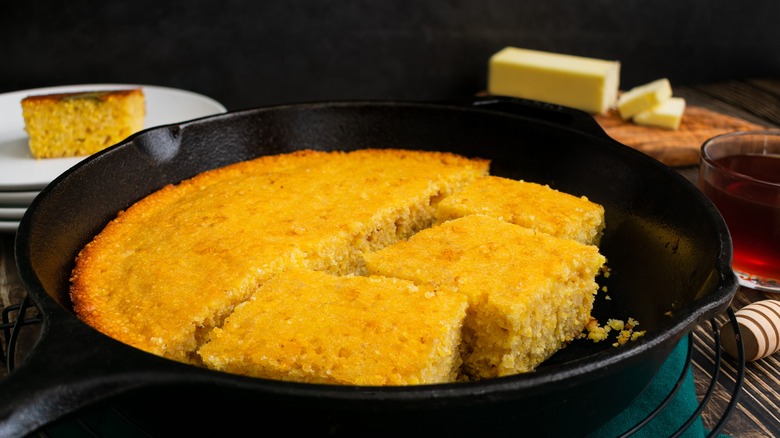Spider Cake: The New England Dish That Makes Cornbread The Main Character
Cornbread, particularly cooked in cast iron, is one of those classic American staples, a must-have at every barbecue as a sort of bread made from cornmeal. But it's eaten in plenty of other contexts, sometimes entirely on its own. It's pretty versatile, so it shouldn't be surprising to see it pop up in many forms, such as sweet foods.
Enter spider cake. This deliriously sweet dish takes a cornbread base and turns it into something a lot more cake-like with the addition of just a few simple ingredients. It can be used as a dessert — and most often is — but it's also meaty enough to become a breakfast food, similar to pancakes or waffles. And the best part is how easy it is to make: You just take regular cornbread and add a bunch of sugar and cream, then top it with maple syrup. Not only does this up the sweet factor considerably, but it also boosts the meal's texture.
It was originally named after the vessel in which it was cooked
Let's get this out of the way first: No spiders are involved in spider cake. Instead, the term is thought to have come as a reference to an 18th-century cast iron frying pan with three legs and an oversized handle, commonly referred to as a "spider" (even if it's a spider missing a whole lot of legs). This was from when cooking still had to be conducted over open flames, so raising the pan gave it airflow and a smoother cooking process — and it was probably how the first spider cakes were cooked. Spider pans went out of fashion when the stoves we know today were created, replaced by simple flat-bottomed cast iron skillets.
We don't know for sure when spider cake was invented; it's the sort of New England recipe that's been around for a long time and doesn't have a clear origin story. We do know that the first written reference to something that looks like spider cake came from an 1832 cookbook called "American Frugal Housewife," where it was referred to as "Indian Cake." (At the time, cornmeal was often called "Indian meal," as corn was a common staple crop of Native American societies in Massachusetts.)
Spider cake has a lot more moisture than regular cornbread
The most significant advantage to spider cake is probably for people who love sweet foods, but there's an ancillary benefit here, too. With cornbread, the constant fight (and the place many cooks trip up) is ensuring it's moist enough; dry cornbread is the constant scourge of bad barbecue. But it's a lot easier to ensure your cornbread dish is moist when you add lots of cream and maple syrup.
This particularly comes into play when you consider how the cream is traditionally deployed. Heavy cream is typically poured into the batter's center after being put into the pan rather than being added to the batter itself. This winds up adding some textural variation, as parts of the spider cake will be more like a custard while others are more solid. This inconsistency is exactly what you want.
If you're a fan of cornbread, you should try making spider cake sometime. It's not only delicious but relatively simple to make, all things considered.


